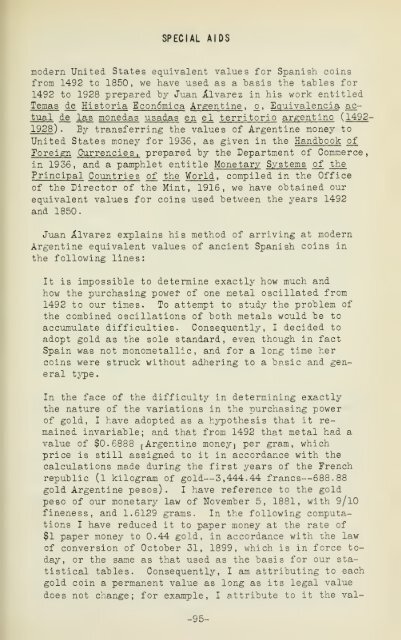Handbook for translators of Spanish historical ... - University Library
Handbook for translators of Spanish historical ... - University Library
Handbook for translators of Spanish historical ... - University Library
You also want an ePaper? Increase the reach of your titles
YUMPU automatically turns print PDFs into web optimized ePapers that Google loves.
SPECIAL AIDS<br />
modern United States equivalent values <strong>for</strong> <strong>Spanish</strong> coins<br />
from 1492 to 1850, we have used as a basis the tables <strong>for</strong><br />
1492 to 1928 prepared by Juan Alvarez in his work entitled<br />
Temas de Historia Econ6mica Argentine ,<br />
o_, Equivalencia actual<br />
de las monedas usadas en el_ territorio argentine (1492-<br />
transferring the values <strong>of</strong> Argentine money to<br />
1928 ) . By<br />
United States money <strong>for</strong> 1936, as given in the <strong>Handbook</strong> <strong>of</strong><br />
Foreign Currencies, prepared by the Department <strong>of</strong> Commerce<br />
in 1936, and a pamphlet entitle Monetary Systems <strong>of</strong> the<br />
Principal Countries <strong>of</strong> the World , compiled in the Office<br />
<strong>of</strong> the Director <strong>of</strong> the Mint, 1916, we have obtained o\ir<br />
equivalent values <strong>for</strong> coins used betv;een the years 1492<br />
and 1850.<br />
Juan Alvarez explains his method <strong>of</strong> arriving at modern<br />
Argentine equivalent values <strong>of</strong> ancient <strong>Spanish</strong> coins in<br />
the following lines:<br />
It is impossible to determine exactly how much and<br />
how the purchasing power <strong>of</strong> one metal oscillated from<br />
1492 to our times. To attempt to study the problem <strong>of</strong><br />
the combined oscillations <strong>of</strong> both metals would be to<br />
accumulate difficulties. Consequently, I decided to<br />
adopt gold as the sole standard, even though in fact<br />
Spain was not monometallic, and <strong>for</strong> a long time her<br />
coins were struck without adhering to a basic and general<br />
type.<br />
In the face <strong>of</strong> the difficulty in determining exactly<br />
the nature <strong>of</strong> the variations in the purchasing power<br />
<strong>of</strong> gold, I have adopted as a hypothesis that it remained<br />
invariable; and that from 1492 that metal had a<br />
value <strong>of</strong> $0.6888 [Argentine money) per gram, which<br />
price is still assigned to it in accordance with the<br />
calculations made during the first years <strong>of</strong> the French<br />
republic (l kilogram <strong>of</strong> gold— 3,444.44 francs— 688.88<br />
gold Argentine pesos). I have reference to the gold<br />
peso <strong>of</strong> our monetary law <strong>of</strong> November 5, 1881, with 9/l0<br />
fineness, and 1.6129 grams. In the following computations<br />
I have reduced it to paper money at the rate <strong>of</strong><br />
$1 paper money to 0.44 gold, in accordance with the law<br />
<strong>of</strong> conversion <strong>of</strong> October 31, 1899, which is in <strong>for</strong>ce today,<br />
or the same as that used as the basis <strong>for</strong> our statistical<br />
tables. Consequently, I am attributing to each<br />
gold coin a permanent value as long as its legal value<br />
does not change; <strong>for</strong> example, I attribute to it the val-<br />
-95-










![Novellen [microform] - University Library](https://img.yumpu.com/21939450/1/171x260/novellen-microform-university-library.jpg?quality=85)
![Anecdota Chisiana de re metrica [microform]](https://img.yumpu.com/21939448/1/190x239/anecdota-chisiana-de-re-metrica-microform.jpg?quality=85)



![Schollenbruch [microform] : Gedichte - University Library](https://img.yumpu.com/21939437/1/174x260/schollenbruch-microform-gedichte-university-library.jpg?quality=85)

